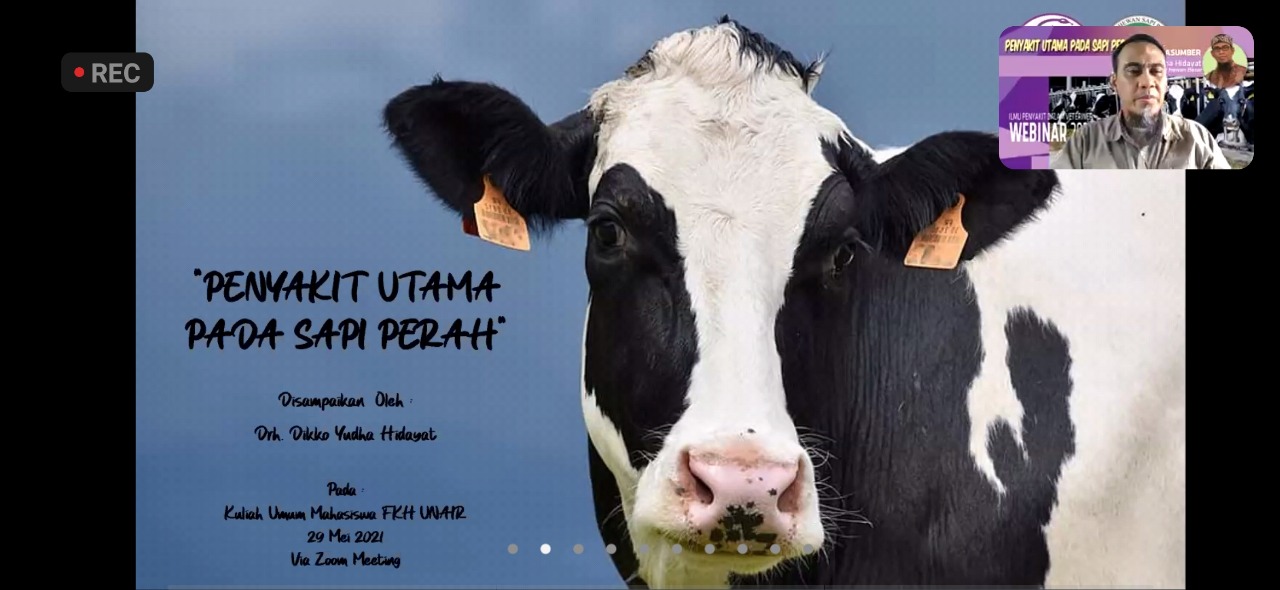UNAIR NEWS – Freedom of Learning-Independent Campus (MBKM) is a policy of the Minister of Education and Culture, which aims to encourage students to master various sciences useful in the professional world. Independent campuses provide opportunities for students to choose courses they will take.
To realize the MBKM program, the Faculty of Veterinary Medicine (FKH) UNAIR, on Saturday, May 29, 2021, held a guest lecture inviting dairy cow expert practitioner, Drh. Dikko Yudha Hidayat. It was held online through the Zoom meeting platform and attended by students taking Veterinary Internal Medicine course.
In the beginning of the session, the Head of the Clinical Division, Prof. Dr. Wiwik Misaco Yuniarti, drh., M.Kes., said that the concept of independent learning aims to provide flexibility for students to learn directly in the business and industrial world.
“This concept is in line with what was developed by Mas Menteri (Nadiem Makarim) as an effort to get quality future leaders,” she explained.
Furthermore, in the presentation entitled “Main Diseases in Dairy Cows”, Dikko said that as field practitioners, we need to build effective communication with farmers.
“The very diverse backgrounds of breeders require us as field veterinarians to be able to empower each other and build communication. Sociology of the rural environment demands that we provide the best service through first impressions in serving,” said veterinarian Dikko.
Furthermore, he added, fostering, assisting and serving the community are the keys to the success of field practitioners, especially for large livestock.
The main disease in dairy cows, he continued, is mastitis. Mastitis is inflammation of the udder tissue due to infection from microorganisms. There are two groups of mastitis, clinical mastitis, with obvious signs (trace, chunk, watery) and subclinical mastitis, with less obvious signs (normal milk).
“Those that affect the incidence of mastitis include health, the environment, humans or the management of the dairy cow’s rearing,” he explained.
“Those that affect the incidence of mastitis include health, the environment, humans or the management of the dairy cow’s rearing,” he explained.
He said mastitis led to decreased milk production, decreased milk quality, additional veterinary cost, potential loss and some cows had to be culled.
Another disease that often occurs in dairy cows is lame or limping. The lame cases, 86% occur in the hind feet, 88% are associated with the nails, and 85% occur in the outer back nails.
“The cause of lameness in dairy cows can be influenced by feed, cage conditions and maintenance management. Foreign objects such as gravel or sand, which are accidentally stepped on by cows, poor maintenance and hygiene systems can result in sole ulcers and lead to lameness,” he said.
Therefore, he continued, paying attention to the quality of the feed provided, good management of the cage and environment is also needed.
In addition to mastitis and lame, other major diseases in dairy cows described by Dr. Dikko are bloat, retained placenta, metritis, milk fever and Bovine Ephemeral Fever (BEF).
Author: Muhammad Suryadiningrat
Editor: Nuri Hermawan





